Java moss (Vesicularia dubyana, but it may actually be Taxiphyllum barbieri) is an aquatic plant from Hypnaceae family. This is a popular aquarium plant. It was named after Swiss plant biologist Dubyana. This plant is quite widely spread in amateur tanks due to its properties: simplicity and the fact that this moss is good as a spawning substrate for fish as well as its incredible decorative effect.
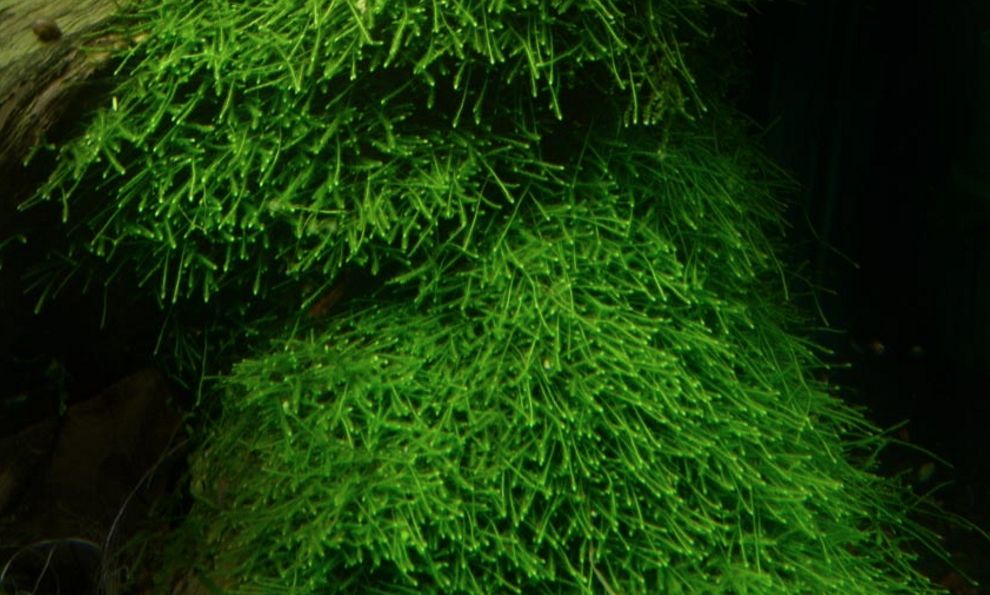
Contents
Habitat in the wild
In the wild you can encounter Java moss in waters of South-East Asia (China, Thailand, Indonesia), particularly in regions such as Java Island, from which it derives its name. The moss is spread around Philippines and Sunda Islands.
It came to Europe from Djakarta botanic garden on Java island which gave it its name. It was Java island after which the moss got its name.
It is an aquatic moss species that grows in freshwater environments, typically in slow-moving or stagnant water bodies such as streams, rivers, and ponds. Java Moss thrives in shaded areas with low to moderate light levels. It often attaches itself to various substrates like rocks, branches, tree roots, and fallen logs. Its versatile nature allows it to grow both submerged and emersed, depending on the water level and environmental conditions.
The moss forms dense mats or carpets, providing shelter, hiding spots, and protection for various aquatic organisms. Its fine and delicate foliage creates a soft and natural appearance, blending seamlessly with the surrounding aquatic vegetation.
In its natural habitat, Java Moss plays an essential role in the ecosystem. It helps in maintaining water quality by absorbing excess nutrients and providing filtration, thus contributing to the overall balance of the aquatic environment. Additionally, the dense growth of Java Moss offers a habitat for microorganisms, small invertebrates, and juvenile fish, providing them with food sources and promoting biodiversity.
The Java moss can get on shores using inshore plant roots and provided with almost 100% air humidity it can travel quite far. In the wild it uses spores for reproduction. At that it can grow them both under water and on the surface.
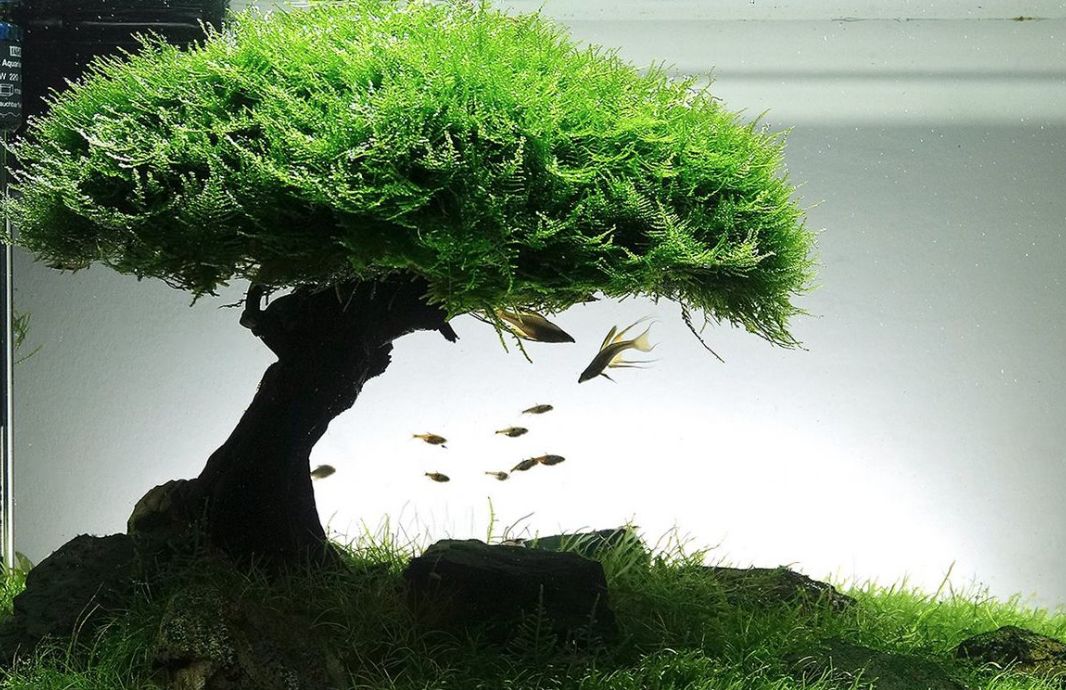
Description
The plant has a soft stem about 17 cm long which is thickly covered with small (up to 2 mm) green leaves. They are pointed and toothed; old leaves are darker colored while young ones are light green.
The Java moss sticks to objects and surfaces due to its rhizoids – extremely thin fibers that consist of one or several protozoa cells which you can see only via microscope.
By means of these rhizoids Java moss absorbs water and nutrients necessary for its growth. However, there is nothing special about it, since such a structure is peculiar to almost all kinds of moss and lichenes.
At first sight it seems that Vesicularia dubyana grows chaotically. But, in fact, this isn’t true. If you take a closer look, you will notice three levels of this aquatic plant:
- the first level of its stems tightly covers the substrate
- the second one is represented by horizontally growing stems that make the whole bush look like it has small arcs inside
- on the third level the stems with leaves grow vertically and make the bush look fluffy
| Characteristic | Description |
|---|---|
| Scientific Name | Taxiphyllum barbieri |
| Common Name | Java Moss |
| Origin | Southeast Asia, specifically from Java Island |
| Growth Rate | Slow to moderate |
| Maximum Height | Around 2-4 inches (5-10 cm) |
| Light Requirements | Low to moderate light (0.5-2 watts per gallon) |
| Temperature Range | 59-86°F (15-30°C) |
| pH Range | 5.0-8.0 |
| Water Hardiness | Soft to moderately hard water |
| CO2 Requirement | Can thrive without CO2 injection, but benefits from supplementation |
| Propagation | Fragmentation, division, and cuttings |
| Ideal Placement | Attached to rocks, driftwood, or mesh for carpets or walls |
| Compatibility | Compatible with most fish, shrimp, and aquatic species |
| Care Level | Easy |
| Benefits | Provides hiding places for fry, absorbs excess nutrients |
| Challenges | Prone to accumulation of debris, may require occasional cleaning |
Difficulties in keeping
Java moss is completely fuss-free aquarium hydrobiont, undemanding in terms of lighting and water parameters. Besides, the moss can grow without a substrate – on snags, stones and other surfaces.
Its only demerit is its slow growth rate. If you expect a bunch of Java moss to grow twice as large in a month, an unpleasant surprise is waiting for you. Though, despite all its sloth-like pace of growth, the moss grows constantly and almost doesn’t stop growing if tank conditions change.
Java Moss is considered a slow to moderate grower. Under favorable conditions, it can grow around 0.5 to 1 inch (1.2 to 2.5 cm) per month. However, growth rates can be highly variable and may differ from tank to tank.
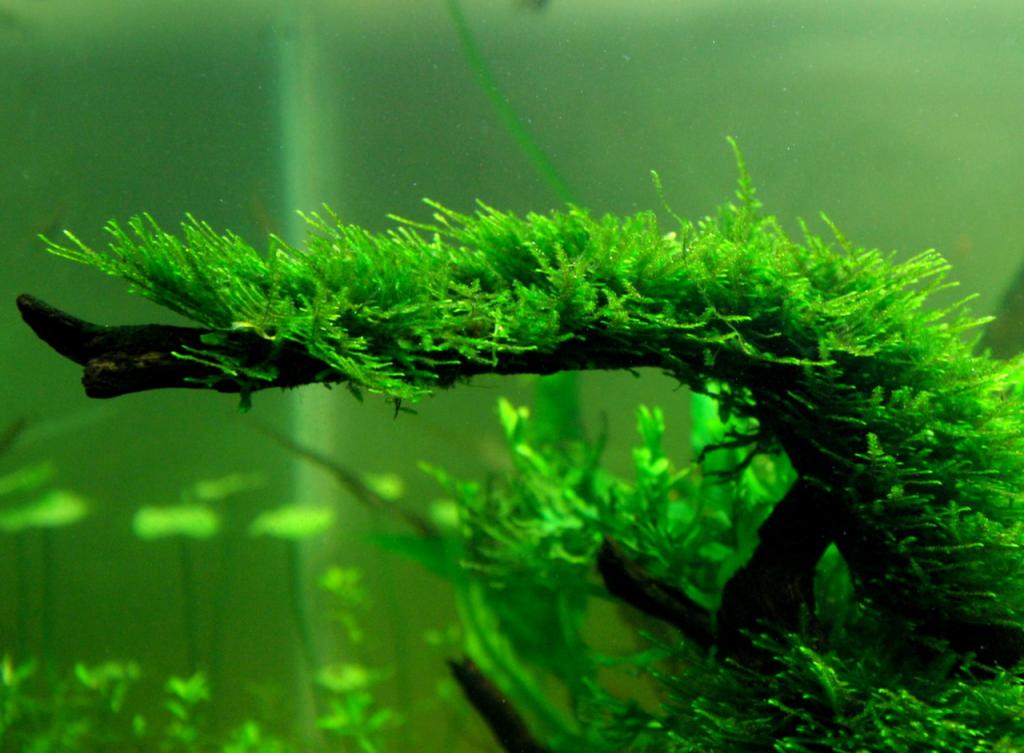
Keeping in a tank
Java moss has been kept in aquariums for quite a long time. When decorating a tank moss looks best on snags, large stones or pieces of flowerpots. You can decorate the back wall of your tank with moss by putting it behind the fixed large-meshed net. You can decorate the tank bottom in the same way.
The plant is a very good looking one and its presence makes the whole tank decorations look more natural. Java moss looks especially good in small tanks. When it grows larger, it can completely cover the back and side walls of the tank.
It’s better to choose large bunch of the Java moss for a tank, since the larger it is, the faster it strikes roots. Java moss isn’t demanding as for the quality and chemical composition of the tank water and it doesn’t require any special care. It grows better in old, but frequently renewed water with sufficient amount of substances that minimize development of lower plants.
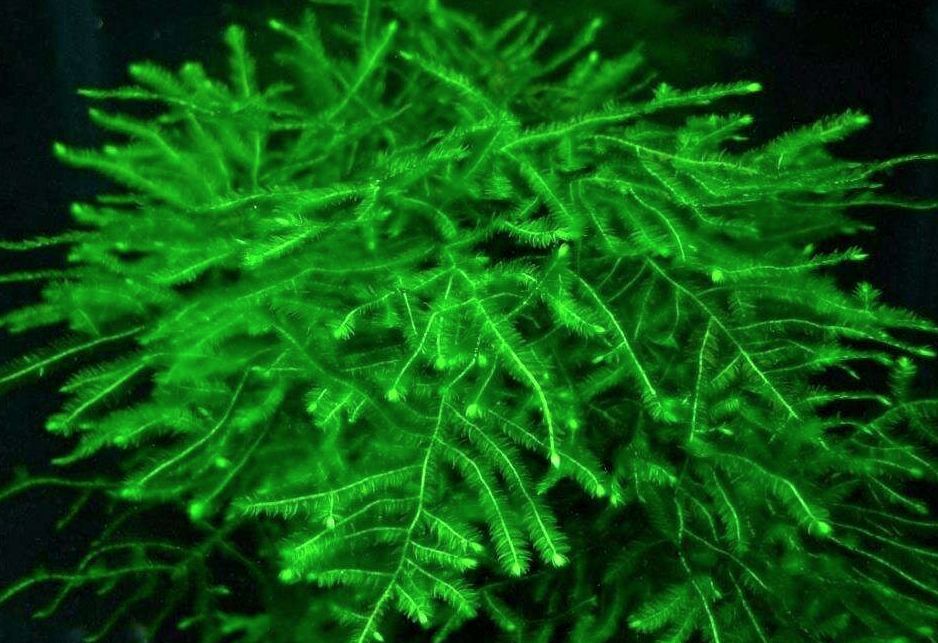
Lighting
Java Moss (Taxiphyllum barbieri) is a versatile plant that can tolerate a wide range of lighting conditions. . It does not require intense lighting like some other plants, making it suitable for setups with standard fluorescent or LED aquarium lights. In its natural habitat, Java Moss is often found in shaded areas, such as under the cover of overhanging vegetation or in dimly lit sections of streams and rivers. This indicates its preference for lower light conditions.
Water parameters
Java Moss can tolerate a wide temperature range, typically between 59°F (15°C) and 86°F (30°C). It can adapt to different water temperatures commonly found in tropical aquariums.
Tank water temperature is set taking into account requirements of all other thermophilic tank dwellers. Java moss shows the best growth rate at water temperature from 70 to 75° Fahrenheit (21 to 24° Celsius). Java moss is also cultivated without water provided with high humidity level.
Java Moss can tolerate a broad pH range, generally between 5.0 and 8.0. It can adapt to slightly acidic to slightly alkaline water conditions. However, a pH around neutral (around 7.0) is generally considered ideal
Java Moss is adaptable to varying water hardness levels. It can tolerate both soft and moderately hard water conditions. It can thrive in a range of water hardness, but moderate hardness is often preferred.
Nutrients
Java Moss is not particularly demanding when it comes to nutrient levels in the water. It can survive in low-nutrient conditions. However, providing a balanced nutrient environment with a source of nitrogen, phosphorus, and micronutrients can promote healthier growth and greener foliage.
CO2
Java Moss is a low-demanding plant that can grow well without the addition of CO2 (carbon dioxide) supplementation in the aquarium. It can obtain the necessary carbon from the surrounding water and naturally occurring carbon dioxide. It is considered a “low-tech” plant that can grow well in aquariums without CO2 injection systems. Java Moss has developed efficient carbon uptake mechanisms, allowing it to adapt to low levels of available carbon dioxide. It can still carry out photosynthesis and grow in aquariums where CO2 concentrations are relatively low compared to high-tech planted tanks.
Nutrients
Java moss doesn’t require any soil dressing mainly because it doesn’t have any root system. This moss gets all micro- and macro fertilizers from water. You can use some liquid fertilizers as extra nutrition for moss. Java moss isn’t demanding in terms of illumination, but excessive light can cause algae growth and it’ll be quite difficult to get rid of it later.
Filtration
An important issue when cultivating Java moss is water purity and proper filtration. Dirty water with mud and suspended matter in it brings long and painful death for the plant.
Don’t let food leftovers, fish metabolic byproducts and other rubbish lay and accumulate on the moss, because the plant pores get clogged and the Java moss won’t be able to breathe. To make sure that the moss looks healthy it’s better to keep cherry shrimps in a tank.
For cherry shrimps a bunch of Java moss is the best place to live. They breed there and their juveniles can hide there from fishes and other tank dwellers. At the same time, for Java moss these shrimps are the best neighbors, because they constantly clean it from dirt and food leftovers.
Green thread algae may appear in bunches in tanks with excessive illumination and it will be quite challenging to get rid of it in this case. This is when Amano shrimps become rather helpful, since they’ll eagerly eat green thread algae.
Java moss easily stands water parameters change. So, it can be used as a spawning substrate for most of fishes. This kind of moss also acidifies water (which is important for Characidae fish), cleans water and absorbs lots of substances dissolved in it (even methylene blue), dirt also settles on the moss.
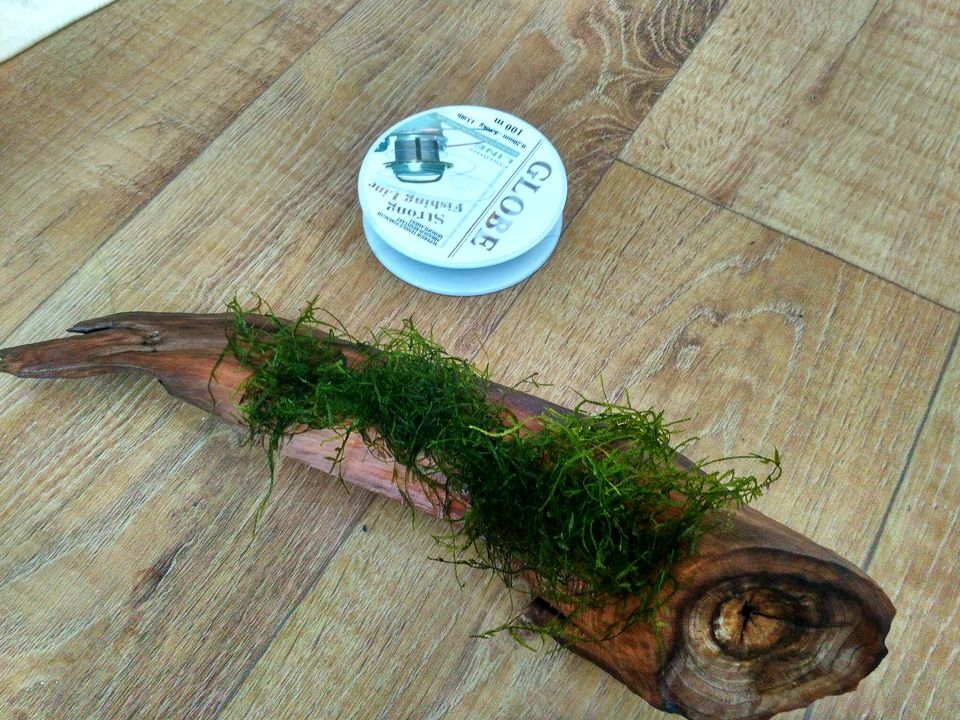
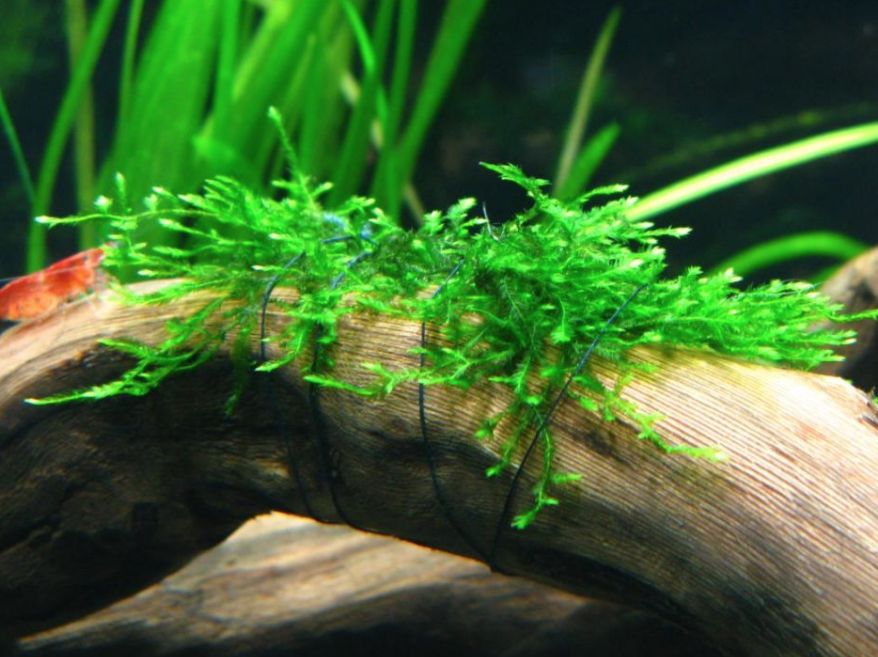
How to plant Java moss
The main principle when planting this moss is quite simple: you should fix the bunch to the surface and in time it will adhere to it on its own. How can you fix the bunch?
Some aquarists just use a thin fishing line. You can tie the Java moss to a snag, stone or any other object, but be careful not to damage its extremely thin leaves. In a week or two, when the rhizoids stick tightly to the substrate you can carefully remove the fishing line. Thin natural cotton thread will also do for this purpose. You won’t have to remove it later, since in time it will rot and gradually dissolve in the tank water.
You can use glue (Superglue with Cyanoacrylate). Avoid using glue with harmful additives or toxic components. Gel-type superglue is preferred as it provides better control and doesn’t contain solvents that can harm aquatic life.
Choose a piece of driftwood, rock, or any other aquarium-safe material where you want to attach the Java Moss. Take a small portion of Java Moss and apply a thin layer of glue to the surface of the chosen material. Use just enough glue to create a sticky surface for the moss to adhere to.
Press the Java Moss gently onto the glued surface. Take care not to apply excessive pressure that may damage the moss. Hold the Java Moss in place for a few seconds to allow the glue to bond securely. Ensure that the moss has good contact with the surface. Let the glue cure and dry according to the instructions provided by the manufacturer. This usually takes a few minutes.
It is a bit difficult to create vertical moss surfaces. If you need to create green background on the back side of your tank, you should tie equally-spaced moss bunches to a plastic grid and then put it vertically. This way of planting Java moss takes much more time.
During the first week the moss grows very slowly, which is quite understandable: the rhizoids need some time for so called rooting. Approximately, in a week or two the plant will quickly grow on the substrate. Java moss is a rather widespread tank plant, which is completely not about its unpretentiousness or the fact that it doesn’t need any special care.
Availability of plant material for implementing all your creative ideas in the field of aquascaping – this is what makes moss popular among aquarists all over the world.
Sources: